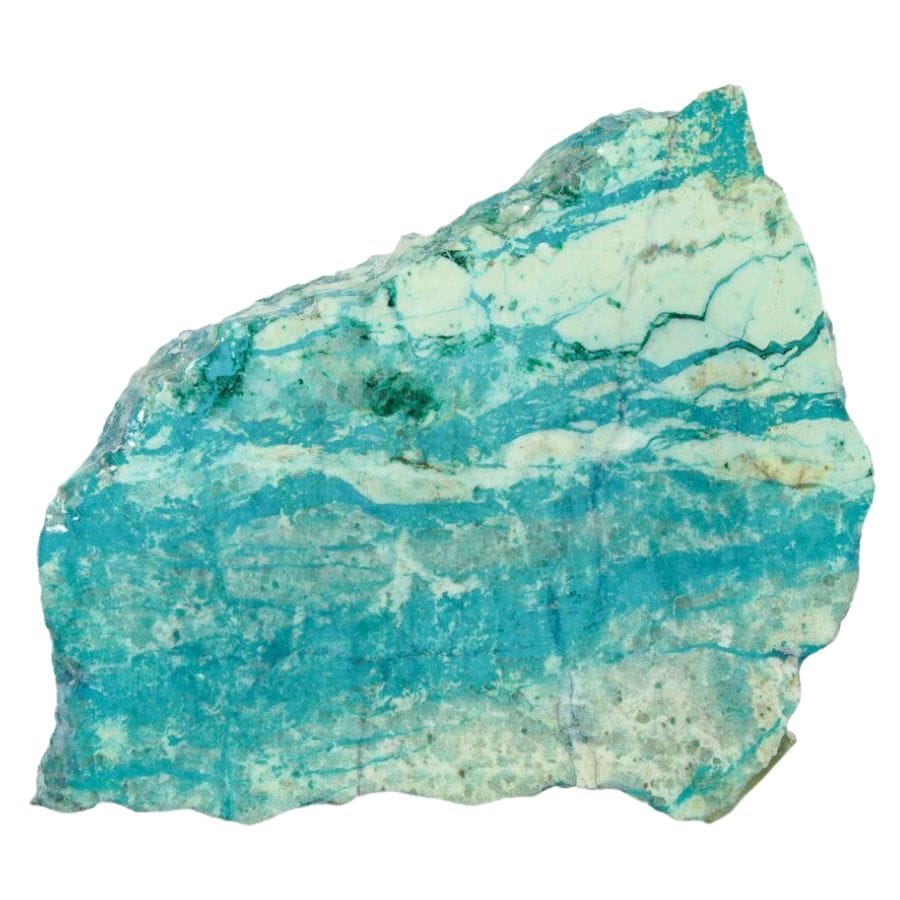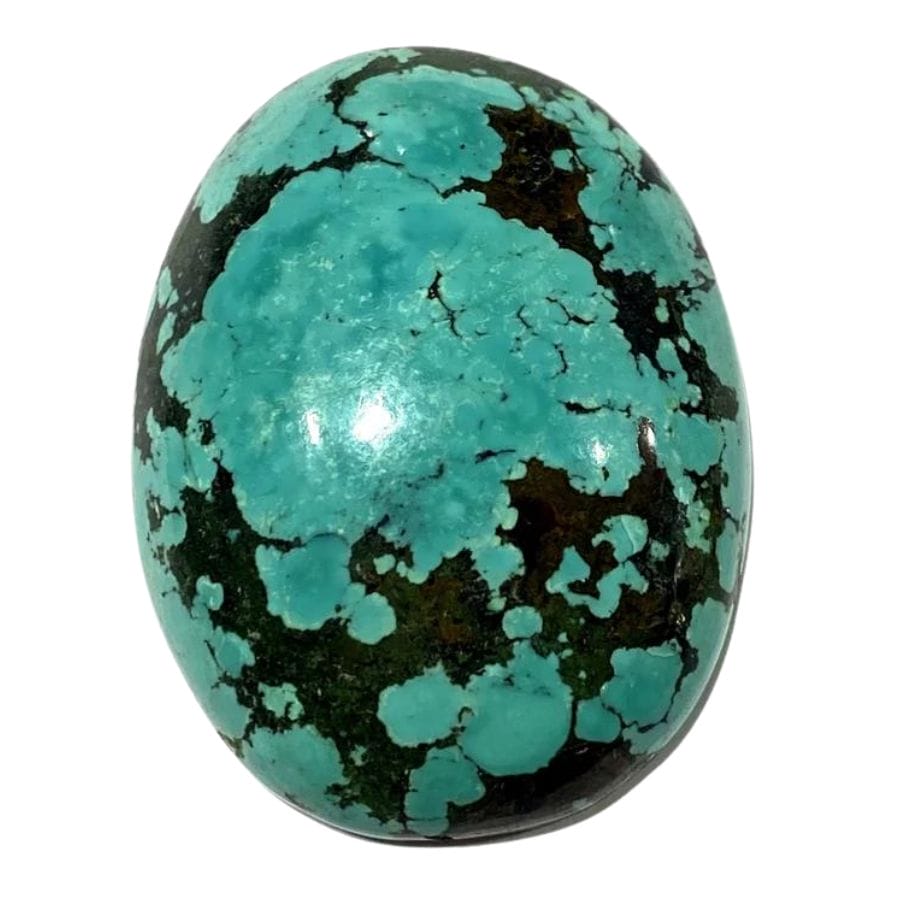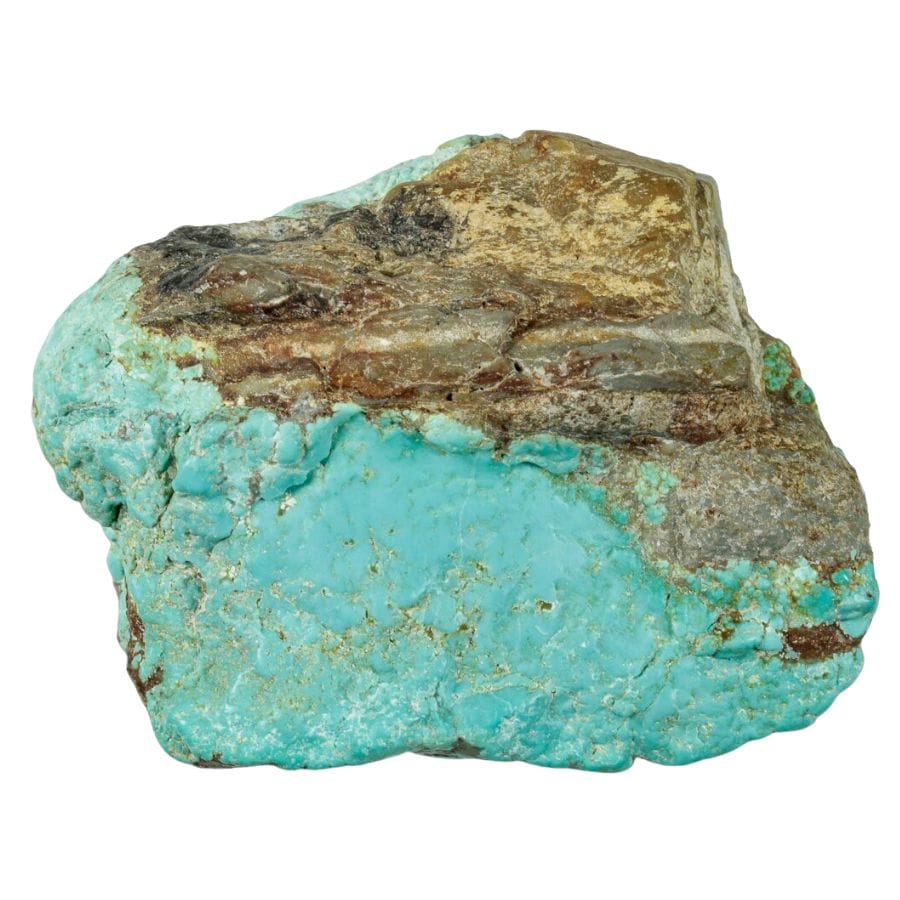Chrysocolla and turquoise are two captivating gemstones that often capture the attention of gem enthusiasts and collectors. To the untrained eye, they might look somewhat similar because of their beautiful blue and green hues.
But for those looking to distinguish chrysocolla vs turquoise, there are some notable differences and similarities that are important to take note of.
We’ll delve deeper into these characteristics, allowing you to gain a clearer understanding of these two beautiful minerals. It’s a journey of discovery that will enrich your appreciation for the natural world of gemstones.
Chrysocolla vs Turquoise – The Major Differences
Chrysocolla and turquoise are both beautiful stones, and it can be hard at first glance to tell them apart. However, when you look closer, there are some clear differences between them.
Colors – Turquoise shows only one base color

Minerals get their colors from the elements inside them. For example, the presence of copper gives both chrysocolla and turquoise their blue-green hues.
Different amounts and combinations of elements create different shades, making each stone unique.
Chrysocolla can show off swirls of both blue and green in one stone. Imagine seeing patches of deep blue next to splashes of green, all combined in unique ways. Sometimes, you might even spot a touch of brown in there.
Turquoise doesn’t mix it up quite as much. Turquoise pieces are usually just one color: either blue, green, or somewhere in between.
You might see some brown or black patterns or lines in it, called the matrix, but the main color stays pretty much the same.
Streak – Chrysocolla has a white or blue-green streak

Streak is an interesting way to learn about minerals. It’s the color a mineral leaves behind when it’s rubbed on a rough surface. Imagine drawing with a crayon on paper, but instead, you’re using a mineral on a special plate called a streak plate.
This plate is usually made of unglazed porcelain and is a bit rough, perfect for this test.
Now, if you want to compare turquoise vs chrysocolla using this method, you’ll see a difference. Chrysocolla leaves a streak that can be white or sometimes blue-green.
On the other hand, turquoise leaves a bluish-white streak.
By looking at the streaks, you can tell these two apart even if their main colors seem similar.
Luster – Turquoise shines like wax

Luster in gemstones is a fun term that describes how light interacts with the surface of a mineral. Think about it like this: when you shine a flashlight on different objects, some might sparkle brightly, while others just reflect the light without any shine.
Chrysocolla is known for its vitreous to dull luster. “Vitreous” means that chrysocolla has a glassy shine. But sometimes, chrysocolla can have a less shiny or dull appearance, too.
Meanwhile, turquoise usually has a waxy to subvitreous luster. This means it might look a little less shiny than chrysocolla. Imagine the look of a candle, which is kind of smooth and a bit shiny but not super sparkly. That’s what turquoise often looks like.
Hardness – Chrysocolla is softer than many minerals

Hardness in gemstones and minerals describes how easily they can be scratched. To measure hardness, we use something called the Mohs scale.
The scale goes from 1 (super soft) to 10 (super hard). So, a mineral with a low number can be scratched easily, while one with a high number is pretty tough.
Chrysocolla is on the softer side of the scale. With a Mohs hardness of 2.5 to 3.5, it’s kind of like a fingernail in terms of how easily it can be scratched. This means you’d need to handle it with care, so it doesn’t get damaged.
Turquoise, on the other hand, is a bit harder. With a hardness of 5 to 6, it’s somewhere in the middle of the scale. It’s tougher than chrysocolla, but still not as hard as something like a diamond, which is a 10 on the scale.
Crystal structure – Turquoise’s crystal structure looks like a slanted box

Crystal structure is like the blueprint or pattern of how the tiny building blocks (called atoms) in a mineral are arranged. These patterns give minerals their unique shapes and properties.
Chrysocolla has what’s called an orthorhombic crystal structure. Think of it as a 3D box where all the corners are 90 degrees, but the sides can be of different lengths. It’s like a stretched-out cube, a bit like a brick or a shoebox.
On the other hand, turquoise has a triclinic crystal structure. This is a little trickier to picture. It’s also like a box, but all its angles and sides can be different lengths. Imagine a wonky box that’s been pushed or pulled in different directions.
Now, while chrysocolla and turquoise have different crystal structures on the inside, they can look similar on the outside. They can both form shapes that look like bunches of grapes. This means that they have a botryoidal crystal habit.
Cleavage – Chrysocolla doesn’t break in smooth, even planes

Some minerals have specific spots where they like to break cleanly and easily, and that’s what we call cleavage.
Chrysocolla doesn’t have a true cleavage. This means it doesn’t have those special lines or planes where it prefers to break. Instead, if you tried to split it, it would break in random, uneven ways.
It’s a bit like trying to break a cookie without any lines – it could crumble any which way!
Turquoise, however, is different. It has good cleavage in one direction. This means if you apply force in that specific direction, it’s more likely to split neatly along that plane.
Chemical composition – Turquoise contains copper and phosphorus

One way to differentiate chrysocolla vs turquoise is to look at their chemical composition. Even though they both contain copper, which gives them a blue-green color, the other elements and how they combine make each mineral unique.
Chrysocolla is a hydrated copper silicate mineral. This means it’s made up of elements like copper, silicon, oxygen, and hydrogen. These elements come together in a specific pattern to make chrysocolla what it is.
On the other hand, turquoise is a phosphate mineral. It’s made up of elements like copper, aluminum, phosphorus, oxygen, and hydrogen. The way these elements combine in turquoise is different from chrysocolla.
Density – Chrysocolla feels lighter

Imagine a small box. If you fill that box with marshmallows, it’ll be light because marshmallows don’t have much matter in them. But if you filled that same box with small rocks, it would be heavy since rocks have more matter packed inside.
Chrysocolla has a density of 1.9 to 2.4 g/cm³. Turquoise is a bit denser, with a density of 2.6 to 2.9 g/cm³. So, if you had a cube of chrysocolla and a similar-sized cube of turquoise, the turquoise cube would feel heavier.
Formation – Turquoise forms in arid areas

Chrysocolla loves areas with lots of copper. When there are copper-rich ore bodies in the ground and they start to oxidize, that’s where chrysocolla steps in. It forms in these oxidation zones, making it a special find for rock enthusiasts.
Turquoise, on the other hand, prefers dry, arid regions. Imagine water slowly seeping through rocks, getting all cozy with copper, aluminum, and phosphates. That mix is where turquoise begins its journey.
For folks interested in finding these gems in the wild, think about the landscapes they come from.
If you’re wondering where to go rockhounding, our guide can show you the terrains where chrysocolla and turquoise, among other treasures, await discovery.
Price – Chrysocolla is more affordable

Gemstones have different price tags, just like toys or clothes. The price of a gemstone isn’t just about how it looks but a lot of other things too.
For instance, how rare it is, the quality, and even where it comes from can make a difference in its price.
Chrysocolla is generally less pricey than a really good quality turquoise. This doesn’t mean chrysocolla isn’t special, but it’s just how the market works.
On the other hand, if turquoise is valuable, it’s often because it has a great color and doesn’t have a lot of marks or spots on it. People love a turquoise that’s a perfect shade of blue without any blemishes.
Location – Turquoise is found in Arizona and other US states

As a copper-bearing mineral, chrysocolla pops up in places with lots of copper deposits. If you’re in the southwestern USA, you might come across it.
Other places around the world, like Chile, Australia, France, England, the former USSR, and Zaire, also have chrysocolla.
On the other hand, turquoise has a few favorite spots too. If you’re traveling to Russia, China, or Iran, you might find some.
And if you’re in the US, especially in states like Arizona, Colorado, Nevada, southern California, and New Mexico, turquoise could be under your feet!
If you’re in any of these states, you can go gem stone mining near you and stumble upon chrysocolla or turquoise.
Turquoise vs Chrysocolla – The Similarities
Diving deeper into gemstones can reveal some cool surprises. Chrysocolla and turquoise are two gems that have a lot in common. Here are the things that make them so alike.
Appearance – Chrysocolla and turquoise are opaque

Chrysocolla is mostly opaque, meaning you can’t see through it. Some pieces might have a bit of a cloudy look, adding to their unique charm.
Turquoise, a favorite for many jewelry pieces, is also primarily opaque. But every now and then, you might find a piece of turquoise that’s slightly translucent, especially if it’s a thin slice.
This means that a tiny bit of light can pass through, giving it a special glow.
Magnetism – Neither mineral has magnetism

Magnetism in minerals refers to their ability to be attracted to a magnet. Just like how magnets stick to your fridge, some minerals can stick to magnets too!
But not all minerals have this ability. It depends on the materials inside the mineral and how they react to magnetic fields.
Chrysocolla and turquoise are generally non-magnetic. This means that if you took a magnet and tried to pick them up or make them stick, it wouldn’t work. They just don’t have the right stuff inside them to respond to the magnet.
Fluorescence – Both gemstones won’t glow under UV light

Fluorescence is a cool thing that happens with some minerals and objects. When they are exposed to ultraviolet (UV) light, which is a type of light we can’t see with our eyes, these minerals can glow in the dark!
Neither chrysocolla nor turquoise typically shows this glowing effect. Chrysocolla doesn’t light up under UV light. The same goes for turquoise; when UV light hits it, it won’t change or glow either.
Conductivity – Turquoise and chrysocolla don’t let electricity pass through them

Conductivity is a word that describes how well something can carry electricity. Think about a metal wire. If you’ve ever seen the inside of a charging cable or an electronic device, you’ve probably noticed thin metal parts or wires.
Those metals, like copper or aluminum, are good conductors, meaning electricity can flow through them easily.
Now, minerals can also conduct electricity, but not all of them do it well. While chrysocolla contains copper, it’s not known to be a good conductor by itself.
Turquoise is similar in this way. It doesn’t really carry electricity despite its copper content.
The Easiest Ways to Tell Chrysocolla and Turquoise Apart
Chrysocolla and turquoise can be tricky to tell apart. But with a few smart methods, we can spot their differences.
Look at the colors

Color can be a helpful clue when you’re trying to figure out the difference between chrysocolla and turquoise.
If you have a stone that’s a mix of different colors like green, blue, and maybe even a touch of brown, you might be looking at chrysocolla. The colors in chrysocolla can swirl together, sort of like paint that hasn’t been fully stirred.
On the other hand, turquoise tends to be more straightforward with its colors. It’s mostly blue or blue-green. Sure, turquoise can have black or brown lines or patterns in it, but the main color stays pretty much the same throughout the stone.
So, if you see a stone that’s mainly one shade of blue or blue-green, it’s likely turquoise.
Check the shine

One way to differentiate chrysocolla and turquoise is by looking at their luster, which is the way they shine or reflect light.
Chrysocolla can vary in its shine. Sometimes it has a bright, glassy shine that catches the eye. Other times, it might appear a bit duller, without much sparkle.
Meanwhile, turquoise is known for its waxy shine. When you look at it, it sort of glows, but not as brightly as something like a diamond. It can also shine somewhat like glass, but the shine is softer and less sharp.
Test the hardness

Chrysocolla is a softer stone than turquoise. If you took a copper penny and tried to scratch a piece of chrysocolla, you’d likely leave a mark. This is because the copper in the penny is harder than the chrysocolla.
Now, imagine you have a piece of turquoise. It’s tougher than chrysocolla. If you tried to scratch it with that same penny, you’d have a hard time leaving any mark at all. This is one of the ways people can tell these two stones apart.

